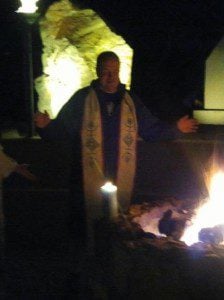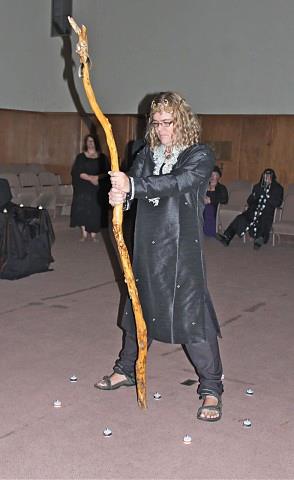I’ve lead a lot large group ritual over the last fifteen years and during that time have come up with a few tricks and tips for getting it right. Over and over again I’ve found that it’s the little things that really make the difference. A lot of what’s below seems like basic common sense stuff, but you’d be surprised how often it’s forgotten by newcomers and adepts alike. Happy ritualing.
1. Make sure to give your ritual participants something to do. This is probably the most difficult and yet most essential element in group ritual. No one simply wants to be “talked at” for the duration of a ritual; they want to be involved and to feel as if they are an integral part of what’s going on.
Ideally the middle of your ritual should provide either a physical activity (and that can vary from dancing to the occasional art project) or an opportunity to connect with something greater. Indulge the senses of your participants. There should be things to see, touch, hear, smell, and perhaps even taste! Be wary of the “we are just going to talk at people” trap. You might think your run down of the Wheel of the Year is interesting, but it’s probably not. If whatever you are doing is not creating some sort of energy it’s probably not working.
A guided meditation is not a physical activity either. There’s nothing wrong with having a guided meditation as a part of whatever you are doing, but it shouldn’t be all that goes on. I’ve been to far too many rituals where the highlight of the afternoon turned out to be a nap.
2. Practice makes perfect. I’ve never understand why some people seem scared of rehearsing. You’ll never really know what works and what doesn’t unless you go over things. You can read and reread a ritual until your heart’s content, but you’ll never really know how it’s going to play out until you run through it a time or two.
A ritual that feels long on paper might only last 35 minutes when actually performed (and this has happened to me often), it’s impossible to tell how long something will be unless you actually do a run through. It pays to go over everything from the blocking to how you are going to distribute the cakes and ale. The best time time to find out that something doesn’t work is during rehearsal, not the next day on Facebook.
 3. Don’t have too many moving parts. The more complicated something is, the more likely it is that something will break. I try to create rituals with a minimum of moving parts, if there’s too much going on there’s a chance people might get lost.
3. Don’t have too many moving parts. The more complicated something is, the more likely it is that something will break. I try to create rituals with a minimum of moving parts, if there’s too much going on there’s a chance people might get lost.
I also don’t like to rely on too many people. A respected High Priestess in my area once put together a great fall rite, and then she lost her voice and her drummers didn’t show up. Things got a bit messy. That’s why I try to make sure that everyone (even me!) is replaceable during ritual, and there’s nothing wrong with a boom-box back-up in case your drummers decide they have something better to do.
4. Speak slowly, loudly, and make sure everything you do is big. You can almost never speak slowly enough in a big crowd. There’s no rush when calling the Lord and Lady, so don’t speed through it. When doing a ritual in front of forty people or more, everything you do should be exaggerated from speech to movement.
When performing the symbolic Great Rite, pick that athame or chalice up deliberately, raise it high over your head, make sure everyone knows exactly what you are doing. It might feel a little funny to you, but that person way over on the far edge of the circle is really going to appreciate it, because they’ll know exactly what’s gong on.
You’d be surprised by the amount of compliments I’ve gotten just for making sure everyone involved in one of my rituals spoke loudly. When you are outside it’s easy for voices to get swallowed up by the various sounds of nature, not to mention trains, planes, and other distractions. A dramatic whisper might be great in your living room with a coven of thirteen, but it doesn’t work in a public park.
5. Never call the quarters at the outside edge of the circle. This is probably the simplest thing on this list. If you call a quarter at the very outside of a circle with your back facing everyone you are only going to be heard by about five people. Call the quarters on the inside of the circle facing the direction you are inviting to your rite.
6. You don’t have to memorize all of your lines, but you should be very familiar with them. There are no actors in my circle, so I don’t expect everyone I ritualize with to memorize their every line. However, no one should ever sound like they are simply reading a ritual for the first time when it comes time to present the rite. If you’ve been doing your rehearsals, your ritual cast should be familiar with their lines, and everything they say should come out cleanly with a minimum of mumbled over words.
I have been to rituals where someone thought their lines were memorized, only to find out that their brain misplaced them somewhere. The momentary memory lapse took the ritual wildly off course, and much of the meaning behind the ritual got lost. It’s not cheating to get something right.
If you do choose to keep your ritual script close to you, make sure to put it in your Book of Shadows, or some other sharp looking book. Reading something off of a normal looking piece of paper does not look very impressive and makes your ritual look like it was put together at the last minute.
7. Know where you are holding your ritual, and adapt accordingly. I have seen good rituals become miserable failures because no one bothered to check up on where the ritual was being held ahead of time. If your ritual is outside do you have a back-up plan in case it rains? Just because your friend offered to let you use their backyard doesn’t mean it’s all clear of dog-poop, and there’s nothing worse than a Maypole dance held in an obstacle course.
If using a public park, make sure to get there early and check the grounds for sticks, trash, and other debris. If your ritual is indoors and at someone’s house make sure the house is picked up and ready for people. (Why people leave their dirty dishes in the sink when they know people are coming over is beyond me.) You want people to focus on the ritual, not the distractions around them or at their feet.
8. Every ritual should have a touch of the familiar. I like being surprised during ritual. There’s something fun about encountering a new twist or seeing a fresh take on an old idea. However that doesn’t mean you should reinvent the wheel in order to get to those moments. Most of us practice what we practice because we like at least a touch of the familiar. If I’m going to what’s advertised as a Wiccan-style ritual I expect a circle and four quarters to be called. The very definition of ritual references “a series of actions performed according to a prescribed order,” if you get too far away from that it’s possible that no one will recognize it as ritual.
I’ve been blessed enough to travel a bit and take part in rituals all across North America. For the most part, all of those rituals have been familiar and I’ve been able to follow along. No one likes to get lost in the middle of a ritual, besides ritual is a shared language, if it’s not at least a little familiar it’s no longer truly shared.
 9. No strange curve balls. It’s always best to avoid things that will make people scratch their heads. You probably shouldn’t call Thor at Imbolc or turn Beltane into a rite for the dearly departed. I was at a Samhain ritual where the High Priestess called a Korean goddess. There’s nothing wrong with Korean goddesses, but it was just so out of left field that it was all I could think about for the next thirty minutes. The inclusion of that particular goddess didn’t make any sense to me on Samhain and no one provided me with an explanation for it.
9. No strange curve balls. It’s always best to avoid things that will make people scratch their heads. You probably shouldn’t call Thor at Imbolc or turn Beltane into a rite for the dearly departed. I was at a Samhain ritual where the High Priestess called a Korean goddess. There’s nothing wrong with Korean goddesses, but it was just so out of left field that it was all I could think about for the next thirty minutes. The inclusion of that particular goddess didn’t make any sense to me on Samhain and no one provided me with an explanation for it.
Most large group ritual is designed for public consumption and in such cases the phrase “keep it simple stupid” often applies. The gods and goddesses one calls should be deities that people are familiar with. If you have to use a deity unfamiliar to most people, make sure you describe them thoroughly either before or during the ritual.
At one huge indoor ritual I attended there was no Cakes and Ale. It’s a part of ritual that’s nearly standard and it felt as if someone had created a huge hole in the middle of ritual because it wasn’t there. I found out later that the hall where the ritual was taking place had a “no food or drink” policy, but it would have been nice to know that before we started. To me it felt like the ritual just wrapped up in a hurry, and I didn’t get that usual grounding moment I’m used to. Just a few words to explain the situation would have gone a long way, as would have a replacement rite.
10. We all need a little help from our friends. The best rituals I’ve ever been a part of had input from a lot of other folks. Sure the words might have ended up being all mine, but a good editor can make all the difference. Don’t be scared to bounce ideas off of other people, and if you are new to ritual, by all means ask for help. We have elders and teachers in our community for a reason, feel free to use them. It’s easy to get defensive sometimes, no one likes their work critiqued, but when I’ve had my rituals put through the wringer, they’ve all come out the better because of it.
Photos
1. From WikiMedia, Francisco de Goya-Witches’ Sabbath(The Great He-Goat)
2. Sean the Druid chants at the cauldron.
3. Your humble author poses with compensation. (Photo by Jennifer Toy.)


















